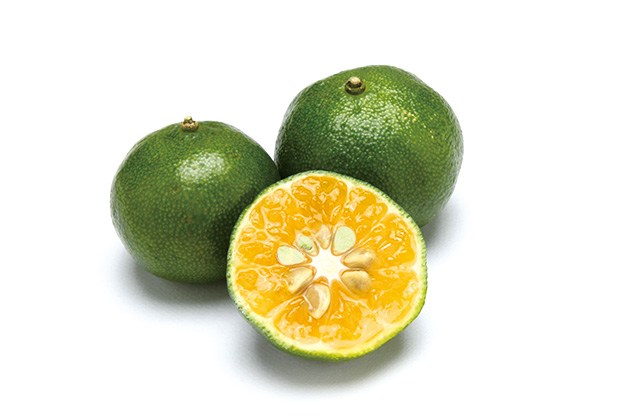“Citrus depressa” is anything but!
“Citrus depressa” may sound like a tropical storm that is about to hit Florida, but this term actually refers to something much tastier. It’s one of several names for a small yet potent citrus fruit that can be found in Okinawa and the Ryukyu Islands of Japan. Known as hirami lemon in Japanese, orshiikwaasa in Okinawan dialect, or sometimes Taiwan tangerine, this fruit packs an intensely sour yet nutritious punch no matter what you call it.
Though grown in the southernmost islands of Japan, the popularity of shiikwaasa through-out the rest of Japan seems to have come from the fruit being featured on a television show nearly 20 years ago. The show focused on the numerous nutritious aspects of the fruit, likely leading many Japanese to start adding it to their diets. Like other citrus fruit, shiikwaasa is known to be full of vitamins such as vitamin C and B1, making it helpful in fighting off a cold. Research has also shown this fruit to help fight stomach cancer and even to lower blood pressure. And like many other foods that are part of the Okinawan diet, this fruit is also believed to contribute to a long and healthy life.
But what is a shiikwaasa? It’s green or yellow on the outside, yellow on the inside, and shaped like its orange-coloured citrus family relative, the tangerine. Despite the colour similarities with the lemons or limes that most of us are familiar with, shiikwaasa is much smaller and more sour than the lemons or limes that you would typically find in the grocery store. In fact, the name in Okinawan dialect literally translates to “sour food.”
When shopping for shiikwaasa, the colour can sometimes make finding this fruit a bit confusing. Young, unripe shiikwaasa are green like a lime, with a coarse skin. This is when the fruit is at its most sour, and it reaches this level of maturity between July and October. More mature shiikwaasa take on the yellow colour of lemons, and are slightly sweeter than the less ripe green version. Yellow shiikwaasa are in season between November and January. Both ripe and unripe versions of the fruit are harvested and enjoyed.
Because of the sour taste, shiikwaasa is often used to make things that would typically be sweetened like jams or juices, and its juice is often blended with other fruit juices or diluted with water to mitigate the intensely sour taste. Shiikwaasa juice can also be used to enhance the taste of grilled fish, or in salad dressing. If you’re looking to mix it up, try using shiikwaasa instead of the usual lemon or lime for a stronger punch. The fruit itself is not very juicy, but because it is so sour, just a drop or two will do!

